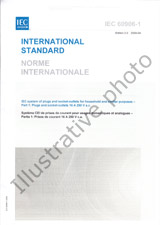We need your consent to use the individual data so that you can see information about your interests, among other things. Click "OK" to give your consent.

IEC 61008-2-1-ed.2.0
Residual current operated circuit-breakers without integral overcurrent protection for household and similar uses (RCCBs) - Part 2-1: RCCBs according to classification 4.1.1
Translate name
STANDARD published on 21.11.2024
The information about the standard:
Designation standards: IEC 61008-2-1-ed.2.0
Publication date standards: 21.11.2024
SKU: NS-1207650
The number of pages: 48
Approximate weight : 144 g (0.32 lbs)
Country: International technical standard
Category: Technical standards IEC
The category - similar standards:
Annotation of standard text IEC 61008-2-1-ed.2.0 :
IEC 61008-2-1:2024 applies to residual current operated circuit-breakers, without integral overcurrent protection, for household and similar uses (hereafter referred to as RCCBs), classified according to IEC 61008-1:2024, 4.1.1. RCCBs according to this document are intended for voltages not exceeding 440 V AC with frequencies of 50 Hz, 60 Hz or 50/60 Hz and currents not exceeding 125 A, intended principally for protection against shock hazard. This second edition cancels and replaces the first edition published in 1990. This edition constitutes a technical revision. This edition includes the following significant technical changes with respect to the previous edition: - harmonization of all clauses between the IEC 61008, IEC 61009 and IEC 60755 series using blocks and modules approach; - harmonization of all tables and figures between the IEC 61008, IEC 61009 and IEC 60755 series; - terms and definitions are now referred to IEC 62873-2; - modification of 4.1 for classification according to supply conditions; - specific tests for operating characteristics (9.9) of RCCB according to classification 4.1.1; - specific test conditions for temperature-rise (9.8), verification of trip-free (9.15), surge current tests (9.19), reliability (9.20) and ageing (9.21). LIEC 61008-2-1:2024 sapplique aux interrupteurs automatiques a courant differentiel residuel sans dispositif de protection contre les surintensites incorpore pour usages domestiques et analogues (ci-apres appeles ID), classes conformement au 4.1.1 de lIEC 61008-1:2024. Les ID conformes a ce document sont concus pour des tensions inferieures ou egales a 440 V en courant alternatif avec une frequence de 50 Hz, 60 Hz ou 50/60 Hz et des courants inferieurs ou egaux a 125 A, et sont destines principalement a la protection contre les chocs electriques. Cette deuxieme edition annule et remplace la premiere edition parue en 1990. Cette edition constitue une revision technique. Cette edition inclut les modifications techniques majeures suivantes par rapport a ledition precedente: - harmonisation de tous les articles entre les series IEC 61008, IEC 61009 et IEC 60755 par une approche fondee sur les blocs et les modules; - harmonisation de tous les tableaux et figures entre les series IEC 61008, IEC 61009 et IEC 60755; - les termes et definitions renvoient desormais a lIEC 62873-2; - modification du 4.1 relatif a la classification selon les conditions dalimentation; - essais specifiques pour les caracteristiques de fonctionnement (9.9) des ID conformes a la classification en 4.1.1; - conditions dessai specifiques pour lechauffement (9.8), verification du declenchement libre (9.15), essais de courant de choc (9.19), fiabilite (9.20) et vieillissement (9.21).
We recommend:
Technical standards updating
Do you want to make sure you use only the valid technical standards?
We can offer you a solution which will provide you a monthly overview concerning the updating of standards which you use.
Would you like to know more? Look at this page.



 Cookies
Cookies
